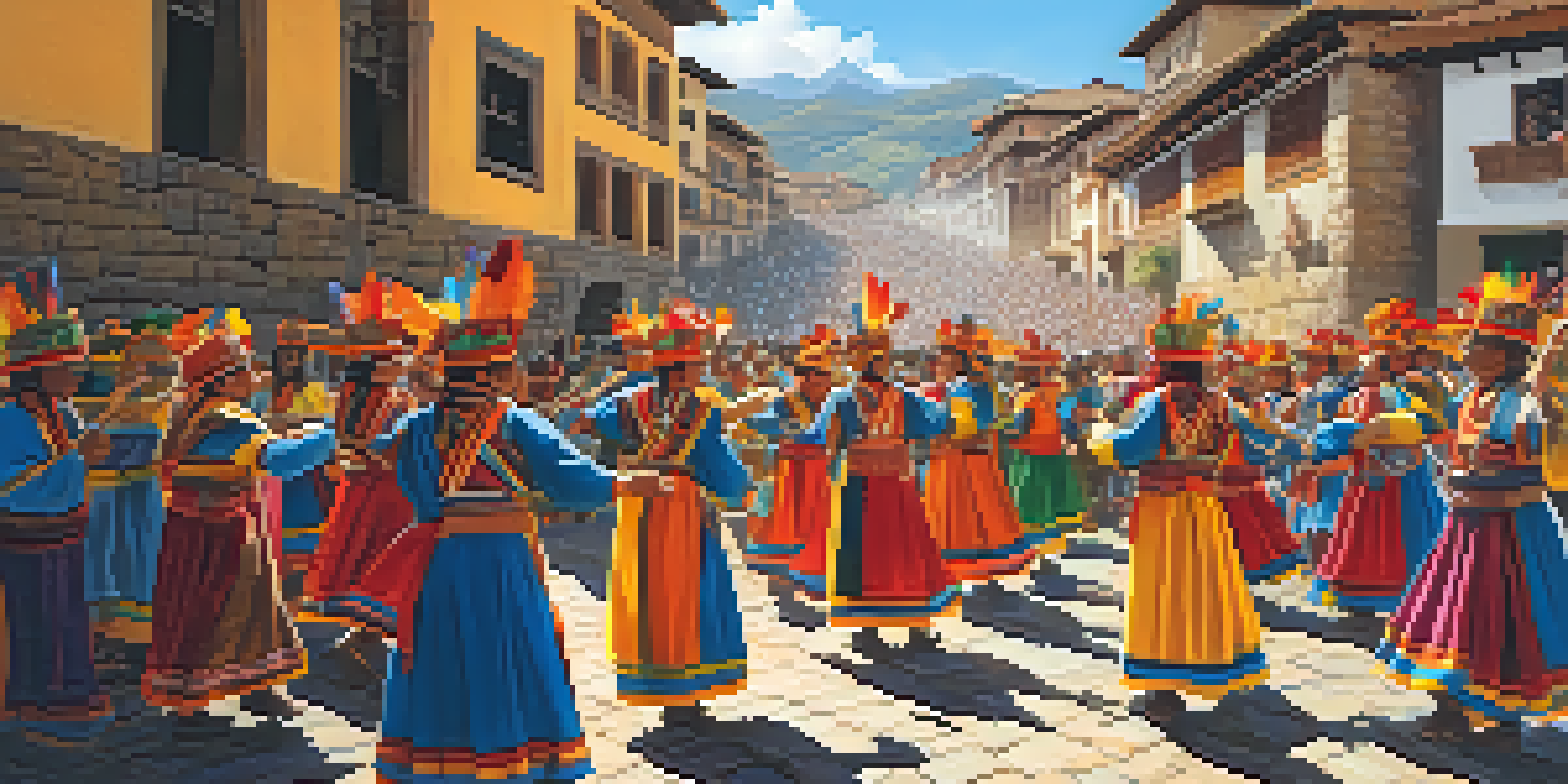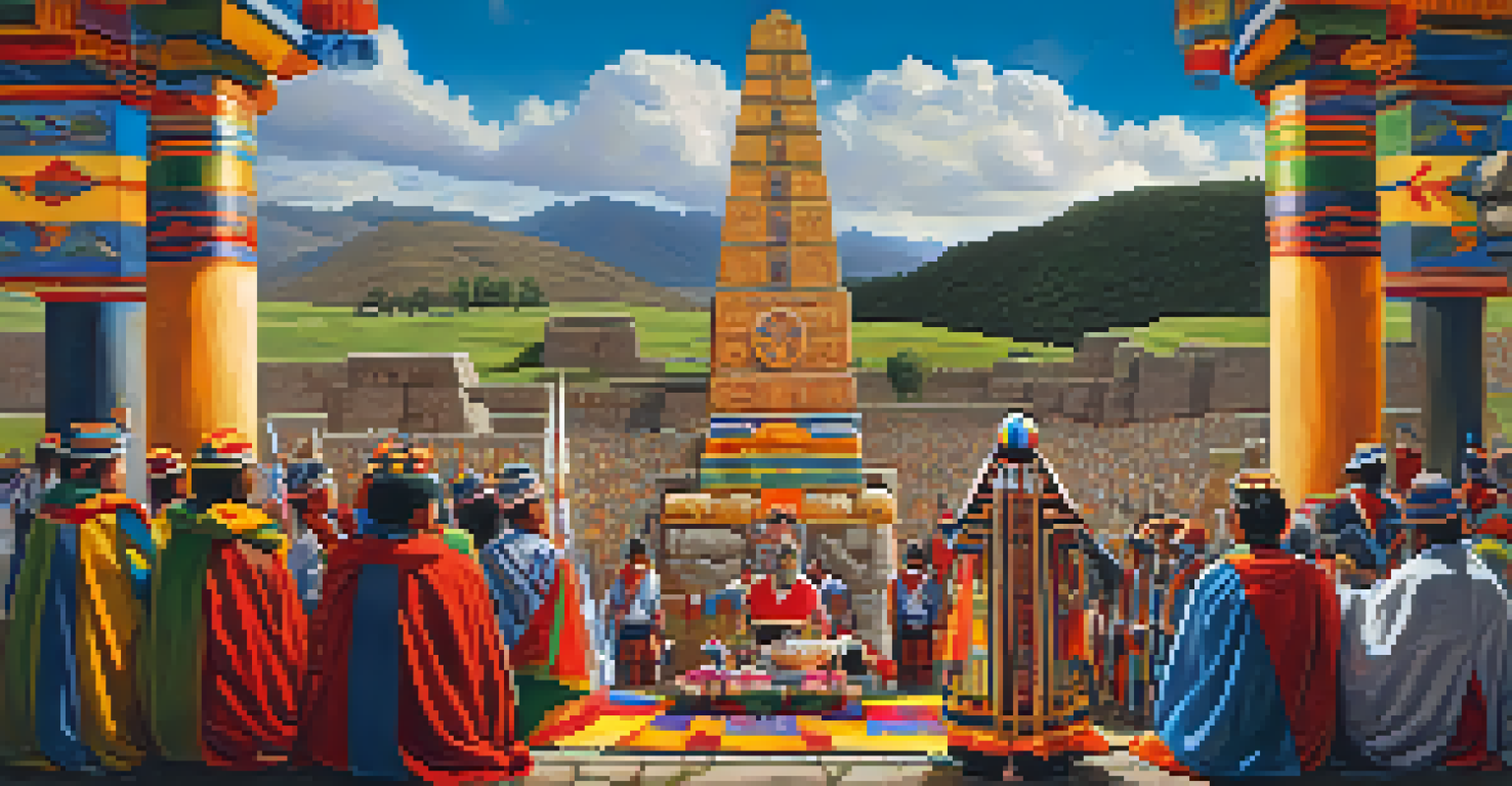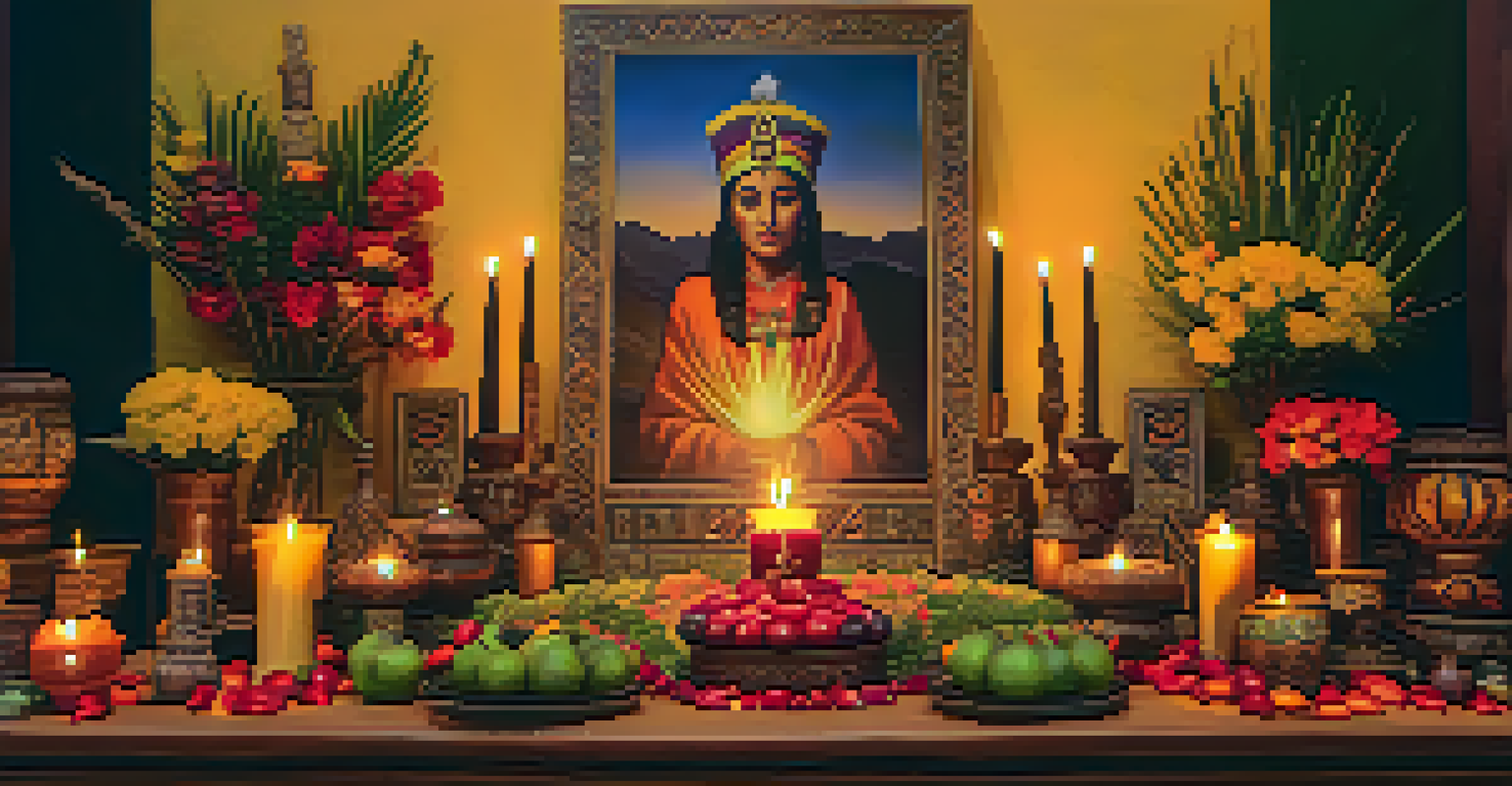Inti Raymi: The Festival of the Sun and Its Spiritual Roots

A Brief History of Inti Raymi Celebration
Inti Raymi, also known as the Festival of the Sun, has its roots in the Inca civilization, dating back to the 15th century. This vibrant festival was initially celebrated in Cusco, Peru, as a tribute to Inti, the sun god, who was believed to be the ancestor of the Inca rulers. The event marked the winter solstice, a time when the sun's light begins to return, symbolizing renewal and hope for the agricultural season ahead.
The sun, with all its power and energy, is a reminder that we are all connected to nature and each other.
During the Inca Empire, Inti Raymi was not just a festival; it was a grand ceremony that involved the entire community. People would gather to participate in rituals, dances, and offerings to the sun, seeking blessings for a fruitful harvest. The festival was a significant part of the Inca calendar, reflecting their deep connection with nature and their reverence for the sun, which was essential for their survival.
Though the festival saw a decline during Spanish colonization, it was revived in the early 20th century, and today it attracts thousands of visitors each year. The modern celebration retains many ancient traditions, showcasing the rich cultural heritage of the Andean people and their ongoing spiritual relationship with the sun.
Understanding the Spiritual Significance of the Festival
The spiritual roots of Inti Raymi run deep, symbolizing the connection between the people and their natural environment. For the Incas, the sun was not just a celestial body; it represented life, warmth, and the source of all energy. The festival served as a reminder of their dependence on the sun for crops and survival, thus fostering a sense of gratitude and respect towards nature.

During the celebrations, various rituals take place, including the offering of llamas and other symbolic items to the sun god. These offerings are made to ensure that Inti blesses the community with good weather and bountiful harvests. The vibrant colors of traditional clothing, the sounds of flutes and drums, and the sights of elaborate ceremonies create a magical atmosphere, immersing participants in the spiritual energy of the event.
Inti Raymi: A Cultural Celebration
Inti Raymi, or the Festival of the Sun, is a vibrant celebration rooted in Inca traditions that honors the sun god and reflects the community's deep connection to nature.
The festival also promotes unity among participants, as it brings together people from different backgrounds to honor their shared heritage. This sense of community is essential in preserving the spiritual and cultural significance of Inti Raymi, allowing both locals and tourists to engage with the traditions that have shaped the Andean identity for centuries.
The Rituals and Activities During Inti Raymi
Inti Raymi is a spectacle of rituals and activities that take place over several days, with the main event occurring on June 24th. The festivities begin with the 'Willaq Umu,' the high priest, who performs rituals to invoke the sun god's presence. This is followed by a procession through the streets of Cusco, where participants dressed in colorful traditional costumes reenact ancient ceremonies, captivating both locals and tourists alike.
Festivals like Inti Raymi remind us of our roots and the importance of honoring those who came before us.
One of the most notable rituals includes the offering of a llama, which symbolizes sacrifice and gratitude. This act is performed at the Sacsayhuamán archaeological site, where the high priest and the community gather to pray for a prosperous year. The llama's blood is seen as a gift to Inti, ensuring his favor and blessings upon the people, thereby reinforcing the spiritual significance of the festival.
Aside from the religious aspects, Inti Raymi also features traditional music, dance performances, and feasting, creating a lively and festive atmosphere. Participants engage in ancient dances that tell stories of the Inca civilization, enriching the cultural experience and allowing the community to connect with their heritage in a meaningful way.
The Role of Ancestors in Inti Raymi Celebrations
The reverence for ancestors plays a vital role in Inti Raymi, as many rituals are dedicated to honoring those who came before. In Inca culture, ancestors were believed to hold significant power and influence over the living, and their memory is celebrated during the festival. This connection to the past fosters a sense of continuity, reminding participants of their roots and the legacy of the Inca civilization.
During the festival, families often prepare altars adorned with pictures and offerings for their ancestors. This practice not only honors the deceased but also strengthens familial bonds, as stories and traditions are passed down through generations. It’s a beautiful reminder of how interconnected life is, transcending time and space.
Spiritual Significance of Inti Raymi
The festival embodies themes of gratitude and reverence for nature, fostering a sense of unity among participants while honoring their ancestors.
By incorporating ancestral elements into the modern celebration, participants ensure that the spiritual significance of Inti Raymi remains intact. This blend of past and present highlights the importance of remembering one's heritage and the values that come with it, enriching the experience for everyone involved.
Inti Raymi's Influence on Modern Spiritual Practices
As we delve into the contemporary world, Inti Raymi continues to influence modern spiritual practices, especially among indigenous communities. Many people have sought to reconnect with their Inca roots, embracing the teachings and traditions passed down through generations. This revival of interest in ancestral knowledge encourages individuals to explore their identity and spirituality in a way that honors their past.
For many, participating in Inti Raymi serves as a form of spiritual renewal, allowing them to reflect on the relationship between nature and humanity. The festival's themes of gratitude, community, and reverence for the earth resonate deeply with those seeking a more meaningful connection with the environment and each other. This focus on spirituality helps individuals cultivate a sense of purpose and belonging in an increasingly disconnected world.
Moreover, as globalization spreads, Inti Raymi has also found its way into the hearts of people from various cultures. Visitors are drawn to the festival's profound spiritual significance, often leaving with a renewed appreciation for nature and a desire to implement similar rituals in their own lives. This cross-cultural exchange enriches the festival, creating a beautiful tapestry of shared spiritual experiences.
The Global Impact of Inti Raymi
Inti Raymi has transcended its local roots, becoming a symbol of cultural pride and identity for many around the world. As people from different countries travel to Cusco to witness the festival, they contribute to a growing global appreciation for Andean traditions and spirituality. This influx of visitors not only boosts the local economy but also fosters a sense of cultural exchange and understanding.
In recent years, Inti Raymi has been featured in documentaries and cultural programs, further highlighting its significance on a global scale. This increased visibility allows others to learn about the rich history, spirituality, and values embodied in the festival, creating a broader dialogue about the importance of preserving indigenous cultures.
Global Impact of Inti Raymi
As Inti Raymi attracts visitors from around the world, it promotes cultural exchange and a broader appreciation for Andean traditions and spirituality.
As the festival continues to capture the hearts of many, it serves as a reminder of the universal themes of connection, gratitude, and respect for nature. This global impact encourages a more inclusive understanding of spirituality, inspiring people to embrace their own heritage while appreciating the diverse traditions that enrich our world.
Visiting Inti Raymi: Tips for Travelers
If you're planning to visit Cusco to experience Inti Raymi, there are a few tips to make your journey memorable. First, it's essential to book accommodations well in advance, as the festival attracts thousands of visitors, and places fill up quickly. Additionally, consider arriving a few days early to acclimate to the altitude and explore the stunning sights of Cusco before the festivities begin.
Dress comfortably and in layers, as the weather can be unpredictable. Also, be sure to partake in local foods and traditions during your visit, as experiencing the culture firsthand will enrich your understanding of the festival. Engaging with locals and participating in pre-festival events can provide deeper insights into the spiritual significance of Inti Raymi.

Lastly, be respectful of the rituals and traditions you encounter. Whether you're taking photos or joining in the festivities, showing appreciation for the cultural significance of the event will enhance your experience and foster goodwill between visitors and the local community. Inti Raymi is not just a spectacle; it's a spiritual journey that connects us all.